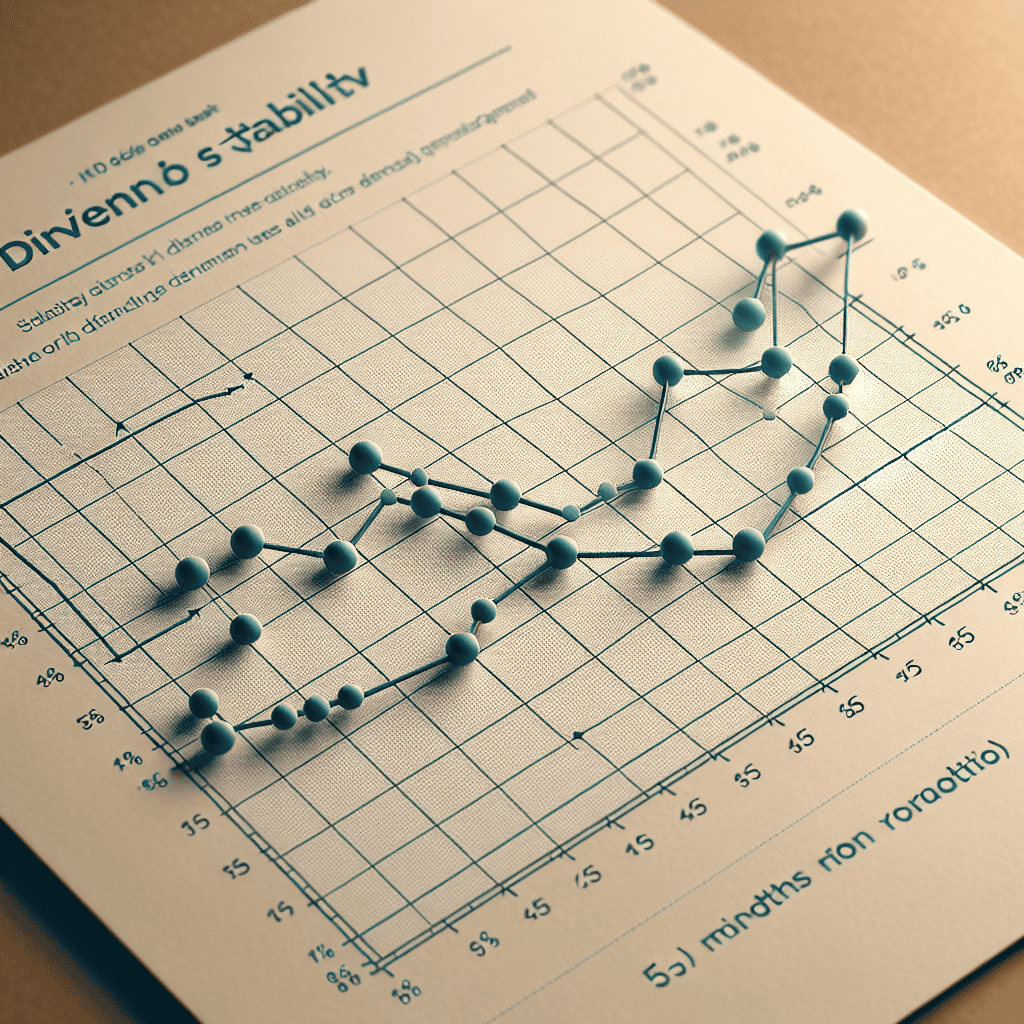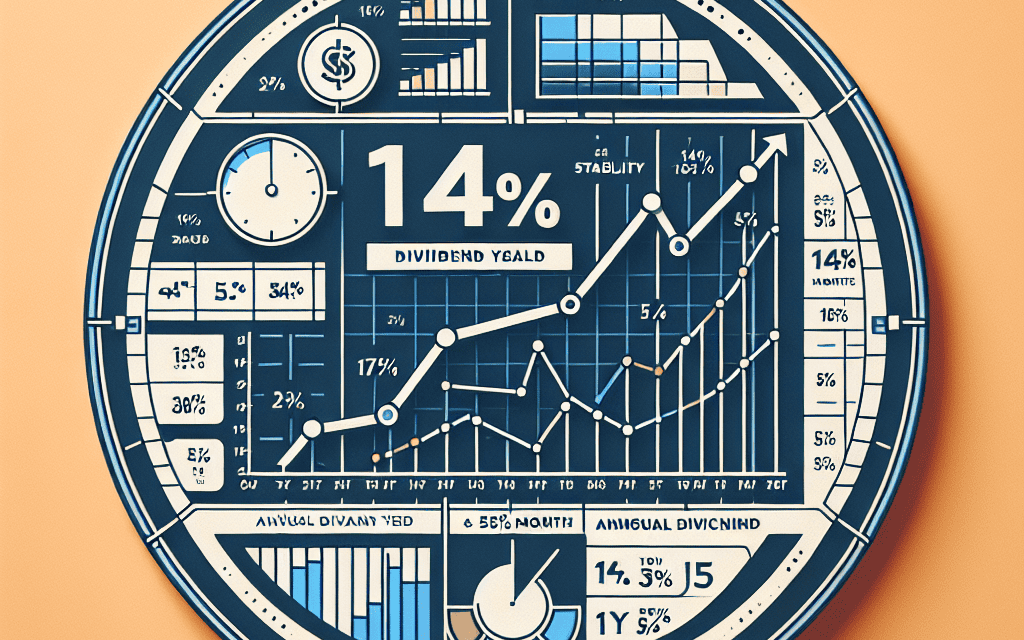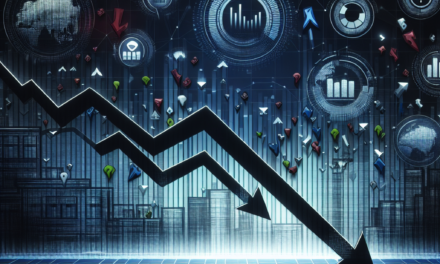“Unyielding Returns: The Quest for Stability in a 14% Dividend Yield”
Introduction
In the ever-evolving landscape of income investing, high-yield dividend stocks often capture the attention of investors seeking robust returns. Among these, a particular stock boasting a 14% dividend yield has piqued interest due to its impressive track record of maintaining stability over 55 months. This intriguing combination of high yield and sustained performance raises critical questions about the underlying factors contributing to its resilience. As investors navigate the complexities of market volatility and economic shifts, understanding the mechanisms that support such a stable dividend yield becomes paramount. This analysis delves into the financial health, strategic positioning, and market conditions that underpin the stock’s ability to sustain its dividend payouts, offering insights into whether this remarkable stability can continue in the face of future challenges.
Analyzing The Historical Performance Of High Dividend Yields
When evaluating the sustainability of a high dividend yield, particularly one as substantial as 14%, it is crucial to delve into the historical performance and underlying factors that have contributed to its stability over an extended period, such as 55 months. High dividend yields can be enticing for investors seeking regular income, yet they often come with inherent risks that necessitate a thorough analysis. By examining the historical performance of such yields, investors can gain insights into whether the yield is likely to be maintained or if it is at risk of being reduced.
To begin with, the consistency of a 14% dividend yield over 55 months suggests a level of stability that is not commonly found in high-yield investments. This stability may be attributed to several factors, including the financial health of the issuing company, its earnings performance, and its ability to generate consistent cash flow. Companies that maintain high dividend yields typically have robust business models and operate in sectors with steady demand. For instance, utilities, telecommunications, and real estate investment trusts (REITs) are known for their ability to provide stable dividends due to their predictable revenue streams.
Moreover, the historical performance of a high dividend yield can be influenced by the company’s dividend policy. A company committed to returning value to shareholders may prioritize maintaining or even increasing its dividend payouts, even during challenging economic periods. This commitment can be a positive indicator of the company’s confidence in its future earnings potential. However, it is essential to consider whether the dividend yield is supported by the company’s earnings and cash flow. A payout ratio, which measures the proportion of earnings paid out as dividends, can provide valuable insights. A payout ratio that is consistently high may indicate that the company is overextending itself, potentially jeopardizing future dividend payments.
In addition to company-specific factors, broader economic conditions can also impact the sustainability of high dividend yields. Economic downturns, changes in interest rates, and shifts in consumer behavior can all affect a company’s ability to maintain its dividend payments. For instance, during periods of economic uncertainty, companies may face declining revenues, which could pressure their ability to sustain high dividend yields. Therefore, it is crucial for investors to consider the macroeconomic environment when assessing the stability of a high dividend yield.
Furthermore, it is important to recognize that past performance is not always indicative of future results. While a 14% dividend yield that has remained stable for 55 months is impressive, investors should remain vigilant and continuously monitor the company’s financial health and market conditions. This ongoing assessment can help identify any potential red flags that may threaten the sustainability of the dividend yield.
In conclusion, while a 14% dividend yield with a 55-month track record of stability is noteworthy, it is essential to conduct a comprehensive analysis of the factors contributing to this performance. By examining the company’s financial health, dividend policy, and the broader economic environment, investors can make informed decisions about the sustainability of such high yields. Ultimately, a cautious and well-researched approach can help investors navigate the complexities of high dividend yield investments and achieve their financial objectives.
Factors Contributing To The Stability Of Dividend Yields
When evaluating the sustainability of a high dividend yield, particularly one as substantial as 14%, it is crucial to consider the various factors that contribute to its stability over an extended period, such as 55 months. A dividend yield of this magnitude often raises questions about its viability, prompting investors to scrutinize the underlying elements that support such a return. To begin with, the financial health of the company issuing the dividend is paramount. A robust balance sheet, characterized by manageable debt levels and strong cash flow, provides a solid foundation for maintaining consistent dividend payments. Companies with a history of prudent financial management are better positioned to weather economic fluctuations, thereby ensuring the continuity of their dividend distributions.
Moreover, the industry in which the company operates plays a significant role in the stability of its dividend yield. Industries that are less susceptible to economic cycles, such as utilities or consumer staples, often provide a more reliable income stream. These sectors typically exhibit steady demand regardless of broader economic conditions, allowing companies within them to generate consistent revenue and, consequently, sustain their dividend payouts. Additionally, companies with diversified revenue streams are generally more resilient, as they are not overly reliant on a single source of income. This diversification can mitigate risks associated with market volatility, further contributing to the stability of dividend yields.
Another critical factor is the company’s dividend policy and its commitment to returning value to shareholders. Companies that prioritize dividend payments and have a track record of maintaining or increasing dividends over time signal a strong commitment to their investors. This commitment is often reflected in the company’s payout ratio, which indicates the proportion of earnings distributed as dividends. A sustainable payout ratio, typically below 70%, suggests that the company retains enough earnings to reinvest in its operations while still rewarding shareholders. This balance between reinvestment and distribution is essential for long-term dividend stability.
Furthermore, macroeconomic conditions can influence the sustainability of high dividend yields. In a low-interest-rate environment, for instance, companies may find it easier to finance their operations and maintain dividend payments. Conversely, rising interest rates can increase borrowing costs, potentially impacting a company’s ability to sustain high dividend yields. Therefore, understanding the broader economic landscape is crucial for assessing the long-term viability of a 14% dividend yield.
In addition to these factors, investor sentiment and market perception can also affect dividend stability. Companies that are perceived as reliable dividend payers often enjoy a loyal investor base, which can provide a buffer against market volatility. This investor confidence can, in turn, support the company’s stock price, reducing the pressure to cut dividends during challenging times.
In conclusion, while a 14% dividend yield is undoubtedly attractive, its sustainability over 55 months hinges on a combination of factors. The company’s financial health, industry characteristics, dividend policy, macroeconomic conditions, and investor sentiment all play integral roles in maintaining dividend stability. By carefully analyzing these elements, investors can make informed decisions about the potential risks and rewards associated with high-yield dividend investments. Ultimately, a comprehensive understanding of these factors can help investors assess whether such a yield can be maintained over the long term.
Risks Associated With High Dividend Yield Investments
Investing in high dividend yield stocks can be an attractive proposition for income-focused investors, particularly when faced with the prospect of a 14% dividend yield. However, the allure of such high returns often comes with a set of inherent risks that must be carefully considered. Understanding these risks is crucial for investors who are contemplating whether a 14% dividend yield can maintain its stability over a 55-month period.
To begin with, it is essential to recognize that high dividend yields can sometimes be a red flag rather than a sign of financial health. Companies offering such yields may be doing so because their stock prices have fallen significantly, often due to underlying business challenges. This decline in stock price can artificially inflate the dividend yield, making it appear more attractive than it might be in reality. Therefore, investors must conduct thorough due diligence to ascertain whether the high yield is a result of genuine profitability or merely a consequence of a declining stock price.
Moreover, companies with high dividend yields may face sustainability issues. A 14% yield suggests that the company is distributing a substantial portion of its earnings as dividends. While this can be beneficial for investors seeking immediate income, it may also indicate that the company is not reinvesting enough in its growth or operational improvements. Over time, this lack of reinvestment can lead to stagnation or even decline, potentially jeopardizing the company’s ability to maintain its dividend payouts.
In addition to sustainability concerns, high dividend yields can also be susceptible to economic fluctuations. Companies that offer such yields are often in sectors that are sensitive to economic cycles, such as real estate, energy, or finance. During economic downturns, these sectors may experience reduced revenues, which can put pressure on their ability to maintain dividend payments. Consequently, investors must be prepared for the possibility of dividend cuts or suspensions during challenging economic periods.
Furthermore, regulatory and market changes can pose significant risks to high dividend yield investments. For instance, changes in tax laws or industry regulations can impact a company’s profitability and, by extension, its ability to pay dividends. Similarly, shifts in market dynamics, such as increased competition or technological advancements, can erode a company’s market share and financial performance, further threatening dividend stability.
Despite these risks, some companies have managed to maintain high dividend yields over extended periods. This stability is often a result of strong management, a robust business model, and a commitment to shareholder returns. Investors should look for companies with a track record of consistent earnings, prudent financial management, and a clear strategy for navigating industry challenges. Additionally, assessing the company’s payout ratio can provide insights into whether the dividend is sustainable. A lower payout ratio suggests that the company retains a portion of its earnings, providing a buffer against potential financial setbacks.
In conclusion, while a 14% dividend yield can be enticing, it is imperative for investors to carefully evaluate the associated risks. By conducting comprehensive research and considering factors such as sustainability, economic sensitivity, and regulatory impacts, investors can make informed decisions about whether such an investment aligns with their financial goals and risk tolerance. Ultimately, the key to successful high dividend yield investing lies in balancing the pursuit of income with a thorough understanding of the potential challenges that may arise.
The Role Of Market Conditions In Dividend Stability

In the ever-evolving landscape of financial markets, dividend stability remains a critical factor for investors seeking reliable income streams. The allure of a 14% dividend yield is undeniably attractive, yet it prompts a crucial question: can such a yield maintain its stability over an extended period, such as 55 months? To address this, it is essential to consider the role of market conditions in influencing dividend stability.
Market conditions, characterized by economic growth, interest rates, and corporate earnings, play a pivotal role in determining the sustainability of dividend yields. During periods of robust economic growth, companies often experience increased revenues and profits, which can support higher dividend payouts. Conversely, economic downturns can strain corporate earnings, potentially leading to dividend cuts. Therefore, understanding the broader economic environment is crucial for assessing the stability of a high dividend yield.
Interest rates, another significant market condition, also impact dividend stability. In a low-interest-rate environment, high-yield dividend stocks become more attractive to investors seeking better returns than those offered by fixed-income securities. This increased demand can support the stock price and, by extension, the dividend yield. However, rising interest rates can pose a challenge. As rates increase, fixed-income investments become more appealing, potentially leading to a shift away from dividend stocks. This shift can exert downward pressure on stock prices, affecting the yield’s sustainability.
Corporate earnings, closely tied to market conditions, are fundamental to dividend stability. A company’s ability to generate consistent profits is directly linked to its capacity to maintain or grow dividend payouts. Companies with strong, stable earnings are better positioned to weather economic fluctuations and sustain their dividend yields. However, firms with volatile earnings may struggle to uphold high dividend payouts during challenging market conditions, risking potential cuts.
Moreover, industry-specific factors can influence dividend stability. Certain sectors, such as utilities and consumer staples, are traditionally known for their stable dividends due to their consistent demand and cash flow. In contrast, industries like technology or energy may experience more volatility, impacting their ability to maintain high dividend yields. Therefore, the sector in which a company operates can significantly affect the sustainability of its dividend.
Additionally, a company’s dividend policy and payout ratio are critical considerations. A conservative payout ratio, where a smaller portion of earnings is distributed as dividends, provides a buffer during economic downturns, enhancing dividend stability. Conversely, a high payout ratio may indicate that a company is distributing most of its earnings, leaving little room for flexibility in challenging times.
In conclusion, while a 14% dividend yield is enticing, its stability over 55 months is contingent upon various market conditions. Economic growth, interest rates, corporate earnings, industry factors, and company-specific policies all play integral roles in determining whether such a yield can be sustained. Investors must carefully evaluate these factors to make informed decisions about the reliability of high-yield dividend stocks. By understanding the interplay between market conditions and dividend stability, investors can better navigate the complexities of the financial markets and achieve their income objectives.
Comparing Dividend Yields Across Different Sectors
In the realm of investment, dividend yields serve as a critical metric for evaluating the potential return on investment, particularly for income-focused investors. A dividend yield of 14% is undeniably attractive, drawing the attention of those seeking substantial income from their investments. However, the sustainability of such a high yield is often questioned, especially when it has maintained stability over a significant period, such as 55 months. To understand the potential for continued stability, it is essential to compare dividend yields across different sectors, as each sector presents unique characteristics and challenges that influence dividend sustainability.
The financial sector, for instance, is traditionally known for offering relatively high dividend yields. Banks and financial institutions often distribute a significant portion of their earnings as dividends, providing investors with a steady income stream. However, the stability of these dividends can be influenced by economic cycles, regulatory changes, and interest rate fluctuations. In contrast, the technology sector typically offers lower dividend yields, as companies in this space often reinvest profits into research and development to drive growth. Nevertheless, some mature tech companies have begun to offer dividends, albeit at lower yields, as they generate consistent cash flows.
Moving to the utilities sector, companies here are known for their stable and predictable cash flows, which often translate into reliable dividend payments. The regulated nature of utilities provides a level of income security, making them a popular choice for conservative investors. However, the yields in this sector, while stable, are generally lower than those in the financial sector. Similarly, the consumer staples sector, which includes companies that produce essential goods, offers stability in dividend payments due to the consistent demand for their products. Yet, like utilities, the yields are typically moderate.
Real estate investment trusts (REITs) are another sector known for high dividend yields, often comparable to the 14% yield in question. REITs are required by law to distribute a significant portion of their income as dividends, which can result in attractive yields. However, the stability of these dividends can be affected by factors such as property market conditions and interest rates. In comparison, the energy sector, particularly oil and gas companies, can offer high yields, but these are often subject to volatility due to fluctuating commodity prices and geopolitical factors.
Given this landscape, a 14% dividend yield that has maintained stability for 55 months is an anomaly that warrants closer examination. The key to its sustainability lies in understanding the underlying business model, cash flow generation, and external factors that could impact future earnings. Companies offering such high yields may be operating in niche markets or possess unique competitive advantages that allow them to sustain high payouts. However, investors must remain vigilant, as high yields can sometimes signal underlying financial distress or unsustainable payout ratios.
In conclusion, while a 14% dividend yield with a track record of stability is enticing, it is crucial to compare it against yields across different sectors to gauge its sustainability. Each sector presents distinct opportunities and risks, and understanding these nuances can help investors make informed decisions. Ultimately, the ability of a company to maintain such a yield depends on its financial health, market conditions, and strategic management, all of which must be carefully evaluated to ensure continued stability.
Strategies For Assessing Dividend Sustainability
When evaluating the sustainability of a dividend yield, particularly one as high as 14%, it is crucial to employ a comprehensive strategy that considers various financial metrics and market conditions. A dividend yield of this magnitude can be enticing for investors seeking income, yet it also raises questions about its long-term viability. To assess whether such a yield can maintain its stability over a 55-month period, investors must delve into the company’s financial health, earnings consistency, and broader economic factors.
First and foremost, examining the company’s financial statements is essential. A high dividend yield often signals that a company’s stock price has decreased, which may indicate underlying financial issues. Therefore, investors should scrutinize the company’s balance sheet, income statement, and cash flow statement. A strong balance sheet with low debt levels and ample cash reserves can provide a cushion for maintaining dividend payments during economic downturns. Additionally, consistent revenue and profit growth are indicators of a company’s ability to sustain its dividend payouts.
Moreover, the payout ratio is a critical metric in evaluating dividend sustainability. This ratio, which measures the proportion of earnings paid out as dividends, can reveal whether a company is overextending itself. A payout ratio exceeding 100% suggests that a company is paying out more in dividends than it earns, which is unsustainable in the long run. Ideally, a company should have a payout ratio that allows for reinvestment in its operations while still rewarding shareholders.
In addition to financial metrics, understanding the company’s industry and market position is vital. Companies operating in stable, mature industries with predictable cash flows are more likely to maintain high dividend yields. Conversely, firms in volatile or rapidly changing sectors may struggle to sustain such payouts. Therefore, investors should consider the competitive landscape and any potential disruptions that could impact the company’s earnings.
Furthermore, management’s commitment to maintaining the dividend is a factor that cannot be overlooked. A history of consistent or increasing dividend payments can signal management’s dedication to returning value to shareholders. However, it is also important to assess whether management’s dividend policy aligns with the company’s long-term strategic goals. If maintaining a high dividend yield compromises necessary investments in growth or innovation, it may not be sustainable.
Economic conditions also play a significant role in dividend sustainability. Interest rates, inflation, and economic growth can all influence a company’s ability to pay dividends. For instance, rising interest rates can increase borrowing costs, potentially squeezing profit margins and affecting dividend payments. Similarly, inflation can erode purchasing power, impacting consumer demand and company revenues. Therefore, investors should remain vigilant about macroeconomic trends that could affect the company’s financial performance.
In conclusion, while a 14% dividend yield is attractive, its sustainability over a 55-month period requires careful analysis. By examining financial health, industry dynamics, management’s commitment, and economic conditions, investors can make informed decisions about the viability of such high yields. Ultimately, a holistic approach that considers both quantitative and qualitative factors will provide the best insights into whether a company can maintain its dividend stability in the face of changing market conditions.
The Impact Of Economic Changes On Dividend Yields
In the ever-evolving landscape of financial markets, dividend yields have long been a focal point for investors seeking both income and stability. A dividend yield of 14% is undeniably attractive, especially in an era where interest rates have been historically low. However, the sustainability of such a high yield over an extended period, such as 55 months, raises questions about the underlying factors that contribute to its stability. Understanding the impact of economic changes on dividend yields is crucial for investors aiming to make informed decisions.
To begin with, dividend yields are influenced by a myriad of economic factors, including interest rates, inflation, and corporate earnings. When interest rates are low, as they have been in recent years, dividend-paying stocks become more appealing to investors seeking higher returns than those offered by traditional fixed-income securities. This increased demand can support higher dividend yields. However, should interest rates rise, the relative attractiveness of dividend stocks may diminish, potentially putting pressure on yields.
Inflation is another critical factor that can impact dividend yields. In an inflationary environment, companies may face higher costs, which can squeeze profit margins and, in turn, affect their ability to maintain or increase dividend payments. For a company to sustain a 14% dividend yield over 55 months, it must have robust financial health and the ability to navigate inflationary pressures without compromising its payout ratio. Companies with strong pricing power and efficient cost management are better positioned to weather inflationary challenges.
Corporate earnings are perhaps the most direct determinant of a company’s ability to maintain its dividend yield. A consistent and growing earnings stream provides the foundation for stable dividend payments. Companies that generate substantial free cash flow are more likely to sustain high dividend yields, even in the face of economic headwinds. However, it is essential to assess whether the earnings growth is driven by sustainable factors or if it is a result of one-time events that may not be replicable in the future.
Moreover, the sector in which a company operates can significantly influence its dividend yield stability. Certain sectors, such as utilities and consumer staples, are traditionally known for their stable cash flows and resilience during economic downturns. These sectors may offer more reliable dividend yields compared to more cyclical industries like technology or consumer discretionary, which can be more susceptible to economic fluctuations.
In addition to these economic factors, company-specific elements such as management’s dividend policy and capital allocation strategy play a crucial role. A company committed to returning capital to shareholders through dividends is more likely to prioritize maintaining its yield, even during challenging times. However, this commitment must be balanced with the need to reinvest in the business for future growth.
In conclusion, while a 14% dividend yield maintained over 55 months is impressive, its sustainability hinges on a complex interplay of economic conditions and company-specific factors. Investors must remain vigilant and consider the broader economic environment, sector dynamics, and the company’s financial health and strategic priorities. By doing so, they can better assess the likelihood of continued stability in dividend yields and make more informed investment decisions. As economic conditions continue to evolve, the ability to adapt and respond to these changes will be paramount in maintaining such an attractive yield.
Q&A
1. **What is the main focus of the article?**
The article examines whether a 14% dividend yield can maintain its stability over a period of 55 months.
2. **What factors are considered in assessing the stability of the dividend yield?**
Factors such as the company’s financial health, cash flow, payout ratio, and market conditions are considered.
3. **How does the company’s financial health impact dividend stability?**
A strong financial position with healthy cash reserves and manageable debt levels supports dividend stability.
4. **Why is cash flow important for maintaining dividend yields?**
Consistent and sufficient cash flow ensures the company can cover dividend payments without financial strain.
5. **What role does the payout ratio play in dividend sustainability?**
A reasonable payout ratio indicates that the company is not overextending itself in paying dividends, which supports sustainability.
6. **How do market conditions affect dividend yield stability?**
Volatile market conditions can impact a company’s earnings and, consequently, its ability to maintain dividend payments.
7. **What is the conclusion regarding the 14% dividend yield’s stability?**
The conclusion typically involves an analysis of the aforementioned factors to determine if the yield is sustainable, though specifics would depend on the company’s unique situation.
Conclusion
The sustainability of a 14% dividend yield over a 55-month period depends on several factors, including the company’s financial health, cash flow stability, payout ratio, and market conditions. A yield this high often indicates elevated risk, and maintaining it requires consistent earnings and cash flow to support the payouts. If the company has a strong balance sheet, low debt levels, and operates in a stable industry, it may be more likely to sustain such a yield. However, external factors like economic downturns or industry disruptions could threaten its stability. Investors should closely monitor these aspects and consider the company’s long-term growth prospects and management’s commitment to maintaining the dividend.





